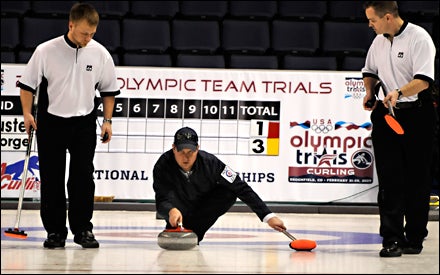“THE FIRST TIME I curled was in junior high,” says John Shuster, a Minnesota native who serves as the men’s skipa combination manager/cleanup hitteron the five-man U.S. Olympic Curling Team. “The local club handed out fliers and we all got a good laugh. Later, I got intrigued.”
Curling? The sport with the brooms? Isn’t that just shuffleboard on ice? Kind of, but there’s more to it than that. It’s complicated and arcane, and for some reason people can’t look away when it’s on television. Heading into Vancouver, curling is the only Winter Olympic sport that increased its TV audience from 2002 to 2006. As a result, NBC plans to air 100 hours of it, plus live streaming video, with matches being played in a new 6,000-seat arena in the most curling-rabid country on the planet, Canada.
“Without a doubt, it will be one of the hottest tickets at the Olympics,” says Molly Solomon, NBC’s coordinating producer for the Vancouver Games.
Since debuting at the Nagano Games, in 1998, curling has become a quadrennial cult hit. In 2006, when the U.S. men won a surprise bronze medal, an average of 876,000 viewers tuned in. Online, the 2006 women’s skip, Cassie Johnson, nearly beat out Bode Miller on ‘s list of most-trafficked athletes.
Curling’s moment has been a long time coming. Originating in Scotland in the 16th century, the sport made its way to Canada in 1759 and got a foothold in the U.S. in 1835, in places like Detroit. In the 175 years since, the sport has blossomed, albeit mostly above the frost line of the Upper Midwest. “Winters are long here,” offers Shuster, “and ice fishing isn’t for everyone.”
Winters are even longer in Canada, where a million people curl (compared with 16,000 in the U.S.), and Canadian teams are perennial powerhousesin three Olympics, they’ve won two gold, two silver, and two bronze medals. Canada, as well as other dominant countries like Switzerland, use a rigorous multiyear process designed to single out the best teams; the U.S. simply sends whatever team wins an open-to-the-public Olympic qualifier. The U.S. method, while compelling, can also lead to inconsistent performances once the Games roll around.
To prepare for the attention, U.S. curling officials instituted a series of off-season training camps, a first. They hired a sports psychologist to mentor the athletes and began using Dartfish software, the same video-analysis technology used by pro skiers, to find minor flaws in their movement. It was a bold advance for a sport that considers post-match beers customarywinner buysand whose Olympians are generally part-time athletes. Shuster manages a bar; Debbie McCormick, the 2010 women’s skip, works at Home Depot and counts pheasant hunting as a hobby.
“It’s addicting to watch, no doubt,” says Rick Patzke, chief operating officer for USA Curling. “But then you want to try it, because it doesn’t look that hard. You think, Hey, here’s my ticket to the Olympics.”


